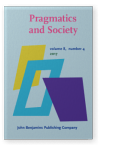The question of power in language classes from a critical discourse analysis perspective
Once a student, always a student?
Informed by the major tenets of critical discourse analysis, the present study attempted to expose the chasm between veteran English teachers enjoying a nation-wide popularity and those linguistically talented novices achieving locally mediocre fame in the Iranian EFL context. In so doing, two highly competent English teachers, each as a prime example of the above-mentioned camps, were selected to serve as the main participants of the research. The analysis of their classroom talk indicated that linguistic excellence could not fulfill the role of educated experience as far as discourse competence was concerned. In all, the discursive strategies used by the experienced teacher seemed to manifest his recognition of students' voices and created a more heteroglossic atmosphere in the classroom.
Article outline
- 1.Introduction
- 2.Review of the related literature
- 2.1Classroom discourse
- 2.2Critical discourse analysis
- 2.3Critical classroom discourse analysis
- 3.Method
- 3.1Participants and class format
- 3.2Data collection procedure and data analysis
- 4.Results
- 4.1Experiential value in vocabulary
- 4.1.1Rewording
- 4.1.2Overwording
- 4.2Relational value in vocabulary
- 4.2.1Euphemism
- 4.2.2Classification schemes
- 4.2.3Formality
- 4.3Expressive value in vocabulary
- 4.4Connective value in vocabulary
- 4.5Experiential value in grammar
- 4.5.1Agency
- 4.5.2Negation
- 4.6Relational value in grammar
- 4.6.1Imperatives
- 4.6.2Modality
- 4.6.3Inclusive we
- 4.6.4Processes
- 4.6.5Turn-taking moves
- 4.7The relational values of interactional conventions
- 4.7.1Connective value in grammar
- 4.7.2Interruption and controlling topic
- 4.7.3Enforcing explicitness and formulation
- 5.Discussion
- 6.Conclusion
-
References
References
Baker, Paul
2006 Using corpora in discourse analysis. London: Continuum International Publishing Group.

Baker, Paul and Sibonile Ellece
2011 Key terms in discourse analysis. London: Continuum International Publishing Group.

Barnes, Douglas
1969 “
Language in the secondary classroom”. In
Language, the learner and the school, ed. by
Douglas Barnes,
James Britton, and
Harold Rosen. 11–77.Harmondsworth: Penguin.

Bellack, Arno A., Herbert Kliebard, Ronald Hyman, and Frank Smith
1966 The language of the classroom. New York: Teachers College Press.

Brookfield, Stephen
2005 The power of critical theory for adult learning and teaching. Berkshire: Open University Press.

Fairclough, Norman
1995 Critical Discourse Analysis. Boston: Addison Wesley.

Fairclough, Norman
2001 Language and Power (2nd ed.). Harlow, U.K.: Longman.

Flanders, Ned A.
1970 Analyzing teaching behavior. Boston: Addison-Wesley.

Fisher, Ros and Shirley Larkin
2008 “
Pedagogy or ideological struggle? An examination of pupils’ and teachers’ expectations for talk in the classroom.”
Language and Education 22 (1): 1–16.


Fröhlich, Maria, Nina Spada, and Patrick Allen
1985 “
Differences in the communicative orientation of L2 classrooms.”
TESOL Quarterly 19 (1): 28–57.


Gee, James Paul
1996 The social linguistics and literacies: Ideology discourses. London: Taylor & Francis.

Gee, James Paul
1999 An introduction to discourse analysis: Theory and method. London: Routledge.

Gee, James Paul
2004 “
Discourse analysis: what makes it critical?” In
An introduction to critical discourse analysis in education, ed. by
Rebecca Rogers. 19–50. Mahwah, N. J.: Lawrence Erlbaum.



Giddens, Anthony
1984 The constitution of society. Cambridge: Polity Press.

Hofstede, Geert
2001 Culture’s Consequences: Comparing values, behaviors, institutions, and organizations across nations (2nd ed.). Berkeley, Calif.: Sage.

Hunt, Kellogg W.
1970 “
Syntactic maturity in schoolchildren and adults.”
Society for the Research in Child Development Monograph 134 (1): 1–67.



Kumaravadivelu, B.
1999 “
Critical classroom discourse analysis.”
TESOL Quarterly 33(3): 453–84.


Levinson, Stephen C.
2000 Presumptive Meanings: The Theory of Generalized Conversational Implicature. Cambridge, Mass.: MIT Press.


Marcuse, Herbert
1964 One-dimensional man: Studies in the ideology of advanced industrial society. Boston: Beacon Press.

Matusov, Eugene
2007 “
Applying Bakhtin scholarship on discourse in education: A critical review essay”.
Educational Theory 57(2): 215–237.


Menard-Warwick, Julia
2008 “
Because she made beds every day: Social positioning, classroom discourse, and language learning.”
Applied Linguistics 29 (2): 267–89.


Partington, Alan
2004 “
Corpora and discourse, a most congruous beast.” In
Corpora and discourse, ed. by
Alan Partington,
John Morley, and
Louann Haarman, 11–20. Bern: Peter Lang.

Reisigl, Martin and Ruth Wodak
2001 Discourse and discrimination: Rhetorics of Racism and Anti-Semitism. London: Routledge.

Sinclair, John and Malcolm Coulthard
1975 Towards an analysis of discourse. Oxford: Oxford University Press.

Van Dijk, Teun
1998 Ideology: A multidisciplinary approach. London: Sage.

Van Dijk, Teun
2001 “
Multidisciplinary CDA: A plea for diversity”. In
Methods of critical discourse analysis by
Ruth Wodak and
Michael Meyer, 95–120. London: Sage.


Walsh, Steve
2006 Investigating classroom discourse. New York: Routledge.


Wodak, Ruth
2001 “
What CDA is about – a summary of its history, important concepts and its developments.” In
Methods of critical discourse analysis, ed. by
Ruth Wodak and
Michael Meyer, 1–13. London: Sage.

Cited by
Cited by 1 other publications
刘, 心语
2021.
A Study on the Teacher-Student Power Relation in Webinar Classes—A Case Study of a Graduate Course.
Modern Linguistics 09:05
► pp. 1315 ff.

This list is based on CrossRef data as of 17 april 2022. Please note that it may not be complete. Sources presented here have been supplied by the respective publishers.
Any errors therein should be reported to them.
